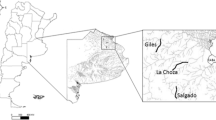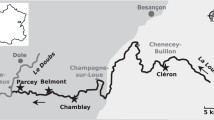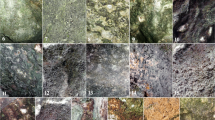Abstract
The authors investigated the microbial composition of phototrophic biofilms proliferating in a show cave using flow cytometry for the first time in such a context. Results are based on several biofilms sampled in the Moidons Caves (France) and concern both heterotrophic prokaryotes and autotrophic microorganisms. Heterotrophic microorganisms with low nucleic acid content were dominant in biofilms, as can be expected from the oligotrophic conditions prevailing within the cave. Analysis of the biofilm autotrophic components revealed the presence of several taxa, particularly the unicellular green algae Chlorella minutissima, specifically well adapted to this cave. Relationships between flow cytometry results and environmental variables determined in the cave were established and discussed so as to better understand biofilm proliferation processes in caves.



Similar content being viewed by others
References
Albertano P (2012) Cyanobacterial biofilms in monuments and caves. In: Whitton BA (ed) Ecology of cyanobacteria II: their diversity in space and time. Springer, Netherlands, pp 317–343
Aleya L (1989) Seasonal couplings between adenyl-nucleotides and photosynthetic activity of size-fractionated phytoplankton in a eutrophic lake. Eur J Protistol 24:381–391
Aleya L (1991) The concept of ecological succession applied to an eutrophic lake through the seasonal coupling of diversity index and several parameters. Arch Hydrobiol 120:327–343
Aleya L, Dauta A, Reynolds CS (2011) Endogenous regulation of the growth-rate responses of a spring-dwelling strain of the freshwater alga, Chlorella minutissima, to light and temperature. Eur J Protistol 47:239–244
Borderie F, Alaoui-Sehmer L, Bousta F, Alaoui-Sossé B, Aleya L (2014a) Cellular and molecular damage caused by high UV-C irradiation of the cave-harvested green alga Chlorella minutissima: implications for cave management. Int Biodeter Biodegr 93:118–130
Borderie F, Tête N, Cailhol D, Alaoui-Sehmer L, Bousta F, Rieffel D, Aleya L, Alaoui-Sossé B (2014b) Factors driving epilithic algal colonization in show caves and new insights into combating biofilm development with UV-C treatments. Sci Total Environ 484:43–52
Borderie F, Alaoui-Sossé B, Aleya L (2015) Heritage materials and biofouling mitigation through UV-C irradiation in show caves: state-of-the-art practices and future challenges. Environ Sci Pollut Res 22:4144–4172
Caneva G, Nugari MP, Salvadori O, 2008. Plant biology for cultural heritage: biodeterioration and conservation. Getty Conservation Institute.
Cennamo P, Marzano C, Ciniglia C, Pinto G, Cappelletti P, Caputo P, Pllio A (2012) A survey of the algal flora of anthropogenic caves of Campi Flegrei (Naples, Italy) archeological district. Journal of Cave and Karst Studies 74:243–250
Cutler NA, Oliver AE, Viles HA, Ahmad S, Whiteley AS (2013) The characterisation of eukaryotic microbial communities on sandstone buildings in Belfast, UK, using TRFLP and 454 pyrosequencing. Int Biodeter Biodegr 82:124–133
Development Core Team R (2011) R: a language and environment for statistical computing. R Foundation for Statistical Computing, Vienna, Austria, URL http://www.R-project.org/.ISBN3-900051-07-0
Dhib A, Denis M, Barani A, Turki S, Aleya L (2016) Ultra- and microplankton assemblages as indicators of trophic status in a Mediterranean lagoon. Ecol Ind 64:59–71
Estrada M, Henriksen P, Gasol J, Casamayor E, Pedros-Alio C (2004) Diversity of planktonic photoautotrophic microorganisms along a salinity gradient as depicted by microscopy flow cytometry, pigment analysis and DNA-based methods. FEMS Microbiol Ecol 49:281–293
Fernández C, Thyssen M, Denis M (2008) Microbial community structure along 18°W (39°N–44.5°N) in the NE Atlantic in late summer 2001 (POMME programme). J Mar Syst 71:46–62
Gasol JM, Zweifel UL, Peters F, Fuhrman JH, Hagstrom A (1999) Significance of size and nucleic acid content heterogeneity as measured by flow cytometry in natural planktonic bacteria. App Env Microbiology 65:4475–4483
Gaylarde PM, Gaylarde CC (2000) Algae and cyanobacteria on painted buildings in Latin America. Int Biodeter Biodegr 46:93–97
Grobbelaar JU (2000) Lithophytic algae: a major threat to the karst formation of show caves. J Appl Phycol 12:309–315
Groth I, Vettermann R, Schuetze B, Schumann P, Saiz-Jimenez C (1999) Actinomycetes in Karstic caves of northern Spain (Altamira and Tito Bustillo). J Microbiol Methods 36:115–122
Heaton T (1986) Caves: a tremendous range in energy environments on earth. National Speleological Society News 44:301–304
John DM., Whitton BA, Broof AJ, 2002. The freshwater algal flora of the British Isles: an identification guide to freshwater and terrestrial algae.
Krakova L, De Leo F, Bruno L, Pangallo D, Urzì C (2015) Complex bacterial diversity in the white biofilms of the Catacombs of St. Callixtus in Rome evidenced by different investigation strategies. Environ Microbiol 17:1738–1752
Krstulovic N, Solic M, Santic D, Marsic-Lucic J, Ordulj M, Sestanovic S (2013) Microbial community structure in two anchialine caves on Mljet Island (Adriatic Sea). Acta Adriat 52:183–198
Lebaron P, Servais P, Baudoux A-C, Bourrain M, Courties C, Parthuisot N (2002) Variations of bacterial-specific activity with cell size and nucleic acid content assessed by flow cytometry. Aquat Microb Ecol 28:131–140
Lefèvre M (1974) La maladie verte de Lascaux. International Institute for Conservation of Historic and Artistic Works 19:126–156
Longnecker K, Sherr BF, Sherr EB (2005) Activity and phylogenetic diversity of bacterial cells with high and low nucleic acid content and electron transport system activity in an upwelling ecosystem. Appl Environ Microbiol 71:7737–7749
Mulec J, Kosi G (2009) Lampenflora algae and methods of growth control. Journal of Cave and Karst Studies 71:109–115
Mulec J, Kosi G, Vrhovsek D (2008) Characterization of cave aerophytic algal communities and effects of irradiance levels on production of pigments. Journal of Cave and Karst Studies 70:3–12
Nugari MP, Pietrini AM, Caneva G, Imperi F, Visca P (2009) Biodeterioration of mural paintings in a rocky habitat: the Crypt of the Original Sin (Matera, Italy). Int Biodeter Biodegr 63:705–711
Prest EI, El-Chakhtoura J, Hammes F, Saikaly PE, van Loosdrecht MCM, Vrouwenvelder JS (2014) Combining flow cytometry and 16S rRNA gene pyrosequencing: a promising approach for drinking water monitoring and characterization. Water Res 63:179–189
Rekik A, Denis M, Aleya L, Maalej S, Ayadi H (2013) Spring plankton community structure and distribution in the north and south coasts of Sfax (Tunisia) after north coast restoration. Mar Pollut Bull 67:82–93
Roldán M, Hernández-Mariné M (2009) Exploring the secret of the three-dimensional architecture of phototrophic biofilms in caves. Int J Speleol 38:41–53
Šantic D, Krstulovic N, Šolic M, Kuspilic G (2012) HNA and LNA bacteria in relation to the activity of heterotrophic bacteria. Acta Adriat 53:25–39
Simon KS, 2012. Cave ecosystems, In Encyclopedia of caves. eds D.C. Culver, W.B. White, pp. 99-102. Academic Press in Elsevier
Stomeo F, Portillo MC, Gonzalez JM, Laiz L, Saiz-Jimenez C (2008) Pseudonocardia in white colonizations in two caves with Paleolithic paintings. Int Biodeter Biodegr 62:483–486
Trigui H, Masmoudi S, Brochier-Armanet C, Barani A, Grégori G, Denis M, Dukan S, Maalej S (2011) Characterization of heterotrophic prokaryote subgroups in the Sfax coastal solar salterns by combining flow cytometry cell sorting and phylogenetic analysis. Extremophiles 15:347–358. doi:10.1007/s00792-011-0364-5
Urzì C, Leo F, Bruno L, Albertano P (2010) Microbial diversity in Paleolithic caves: a study case on the phototrophic biofilms of the Cave of Bats (Zuheros, Spain). Microb Ecol 60:116–129
Zhao L, Denis M, Barani A, Beker B, Mante C, Xiao T, Gregori G (2012) Possible bloom of free trichomes in the Bay of Marseille, NW Mediterranean Sea: an anomaly evidenced by flow cytometry. J Plankton Res 12:231–242
Zubkov MV, Fuchs BM, Burkill PH, Amann R (2001) Comparison of cellular and biomass specific activities of dominant bacterioplankton groups in stratified waters of the Celtic Sea. App Env Microbiology 67:5210–5218
Acknowledgments
We gratefully thank the owners of the Moidons Caves, Isabelle and François Gauthier, who kindly gave us access to the cave to collect samples. We also thank Dominique Rieffel and Didier Cailhol for their technical assistance during field work within the cave, and Serge Nitsche, head of the SEM facility at the Centre Interdisciplinaire de Nanoscience de Marseille (CINaM), for his helpful assistance and for providing access to SEM. Finally, we thank the Editor Pr. Robert Duran and the two anonymous reviewers whose comments have helped to greatly improve the manuscript.
Author information
Authors and Affiliations
Corresponding author
Ethics declarations
Conflict of interest
The authors declare that they have no conflict of interest.
Additional information
Responsible editor: Robert Duran
Rights and permissions
About this article
Cite this article
Borderie, F., Denis, M., Barani, A. et al. Microbial composition and ecological features of phototrophic biofilms proliferating in the Moidons Caves (France): investigation at the single-cell level. Environ Sci Pollut Res 23, 12039–12049 (2016). https://doi.org/10.1007/s11356-016-6414-x
Received:
Accepted:
Published:
Issue Date:
DOI: https://doi.org/10.1007/s11356-016-6414-x




